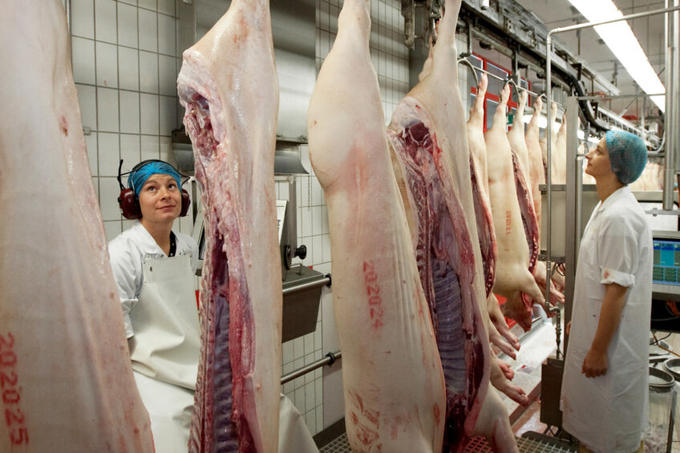November 18, 2025 | 23:11 GMT +7
November 18, 2025 | 23:11 GMT +7
Hotline: 0913.378.918
November 18, 2025 | 23:11 GMT +7
Hotline: 0913.378.918

Slaughterlines in Germany were slightly busier than last year in the first 6 months of this year. Photo: Ronald Hissink.
In the first 6 months of 2024, 21.9 million pigs were slaughtered in the number #2 pig country in the European Union. That was 0.4% or 78,100 animals more than in the same period last year, the federal statistics office Destatis reported. The increase follows a decrease by 6.9% of the number of slaughtered pigs in 2023.
Those slaughter figures resulted in a production of 2.1 million tons of pig meat, 22,400 tons or 1.1% higher year-on-year. After a long decline of the production figures, this is the first time since 2016 that pork production in Germany showed an year-on-year increase, the statistical authority comments.
In the first half of 2024, 21.1 million of pigs slaughtered came from German pig farms. That represents a share of 96.6%, 0.4% more than in the same time frame of 2023. The other 734,000 animals came from other countries, mostly the Netherlands, Denmark and Belgium, representing 3.4% of the total number of slaughtered pigs.
It should be noted that this figures have not yet been influenced by recent outbreaks of African Swine Fever (ASF) in the west of the country. Over the last few weeks, a number of new ASF cases were found in several states including Hesse, Rhineland-Palatinate and Badem-Württemberg.
The total meat production in Germany in the 1st half of 2024 amounted to 3.4 million tons, 1.3% more than in the first half of 2023. Altogether, German slaughter facilities processed 24 million pigs, cattle, sheep, goats and horses as well as 344.3 million chicken and other poultry. 62% of all the produced meat came from pigs, confirming that they still count for the vast majority of the total meat production in the country.
Meanwhile, earlier figures from Destatis show that the decline in pork consumption shows no signs of stopping. In 2023, roughly 2.92 million tons of pork were consumed in Germany, a decrease compared to the previous year figure of 2.97 million tons. Germans don’t seem to appreciate their own sausages as much as they used to do, while the increase in the consumption of meat alternatives also plays an increasingly important role.
(PP)

(VAN) Flagship partnership secures additional GBP 16.9 million to strengthen forest monitoring, transparency and country support to 2030.

(VAN) After a turbulent year for international development, the aid and assistance landscape has shifted, with donors rethinking how, where and why they support sustainable development.

(VAN) A new tool for measuring the economic value of farm animal welfare improvements has been developed, potentially transforming how consumers, retailers and the government evaluate animal welfare policies.

(VAN) The Amazon rainforest could face a renewed surge of deforestation as efforts grow to overturn a long-standing ban that has protected it.

(VAN) Conflict and violence are driving extreme hunger in six major crises.

(VAN) European Union member states are seeking to postpone the implementation of the bloc's anti-deforestation law by another year, an EU negotiating draft dated November 10 shows.

(VAN) Nearly 30 new avian influenza outbreaks have recently been reported in Germany, both on commercial poultry farms and in backyard flocks.